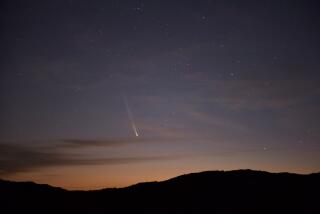Celestial Spectacle
- Share via
As Comet Hale-Bopp blazes its way across the Ventura County sky as possibly the brightest comet of the 20th century, sky watchers can catch a glimpse of cosmic history right from their backyards. It can be seen with the naked eye, but is most dramatically viewed through binoculars or a small telescope. Getting away from city lights allows for viewing of the full length of the comet’s streaming tail.
But catch Hale-Bopp now, because it won’t return until the year 4357. It has been traveling in the nether reaches of the solar system and was last seen about 2200 B.C. The comet was discovered in July 1995, when it was beyond the orbit of Jupiter, by two astronomers who were stargazing 400 miles apart. Professional astronomer Alan Hale in New Mexico and amateur astronomer Thomas Bopp in Arizona are credited with discovering C/1995 O1, Hale-Bopp’s formal title.
As it makes its way through the solar system, Hale-Bopp will speed toward the sun and away again. Along the way, it will provide scientists with rare insight into the solar system’s origins. “All this material [that makes up the comet] was present when the solar system was forming,” said Griffith Park astronomer Patrick So. “Finding out what comets are made of gives astronomers some idea of what formed the solar system 4.5 billion years ago.”
Composition of a Comet
Nucleus: A comet’s nucleus, often referred to as a “dirty snowball,” is a mix of ice, silicate dust and sometimes frozen carbon dioxide and carbon monoxide. The nucleus usually measures 5 to 10 miles across, but Hale-Bopp’s is much larger, an estimated 25 miles in diameter.
Makeup of nuclues
Gases and water: 70-80%
Meteric particles: 20-30%
Gas tail
Solar wind blows coma material back behind the nucleus, creating a tail. Coma material becomes electrically charged as the sun’s heat breaks down gas molecules from the nucleus into ions. Solar wind repels the ions away from the sun.
Dust Tail
Often seen drifting away from a comet is a duller tail composed of dust grains from the coma, which shine from reflected sunlight. A comet’s tail can stretch 100 million miles across space.
Hale-Bopp’s Orbit
Unlike the more circular orbit of a planet, a comet’s orbit around the sun is a long and narrow ellipse. Some comets orbit in periods of less than seven years. Others, like Hale-Bopp, pass the sun only once in thousands of years. Hale-Bopp’s orbit is extremely long--about 10 times the distance between Pluto and the sun.
Orbit path above plane of Earth’s orbit
Orbit path below plane of Earth’s orbit
Comet Facts
Why It Gets Brighter
The point in the comet’s orbit when it’s closest to the sun is called perihelion. Hale-Bopp reached perihelion on Tuesday when it was 85 million miles from he sun. That marked the point at which it was probably most active, as more gas and dust were driven off the nucleus.
Comet Rotation
Hale-Bopp is on about an 11-hour rotation. It is spinning faster than most comets, which usually take a few days to make a complete rotation. In addition, scientists are noticing a dramatic spiral pattern of gas radiating from the nucleus.
How to View It
The best time to see the comet from now through May is early evening, above the northwest horizon. Shown below is its position about a hour and a half after sunset. The sun sets today at 6:20 in Ventura County.
Great Comets
*--*
First Period of recorded orbit in sighting years Halley’s Comet 1682 76 1910-1 Comet 1910 4 million Comet Mrkos 1957 13,200 Comet Ikeya- 1965 880 Seki Comet Bennett 1969 1,680 Comet West 1976 500,000 Comet Hale-Bopp 1995 2,380 Comet Hyakutake 1995 14,000
*--*
Where to See It
Griffith Observatory: Public viewing each evening , through the 12-inch Zeiss refractor telescope on the observatory roof and through portable telescopes set up on the lawn. Call (213) 664-1181
Moorpark College: The Ventura County Astronomical Society is inviting the public to view the Hale-Bopp Comet at the Charles Temple Observeratory at Moorpark College on April 12 at 6:30 p.m. The observatory lies on the eastern end of the campus off Campus Road in Moorpark. Call 529-7813.
*
Griffith Observatory Site:
http//www.GriffithObs.org
Hale-Bopp Comet Site:
http//www.halebop.com
Jet Propulsion Laboratory Site:http//www.jpl.nasa.gov/comet/
Ventura County Astronomical Society Site
https://www.serve.net/vcas/vcas.html
Sources: Patrick So, Griffith Observatory; World Book Encyclopedia. Researched by JULIE SHEER/Los Angeles Times






